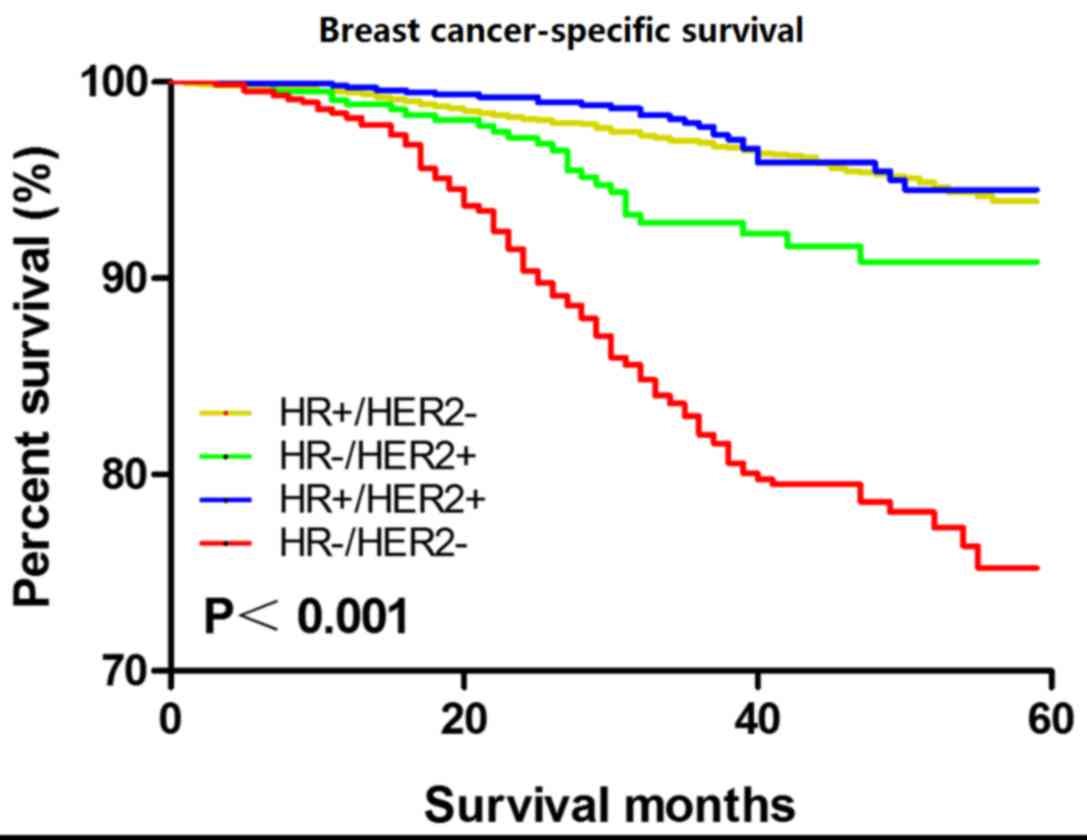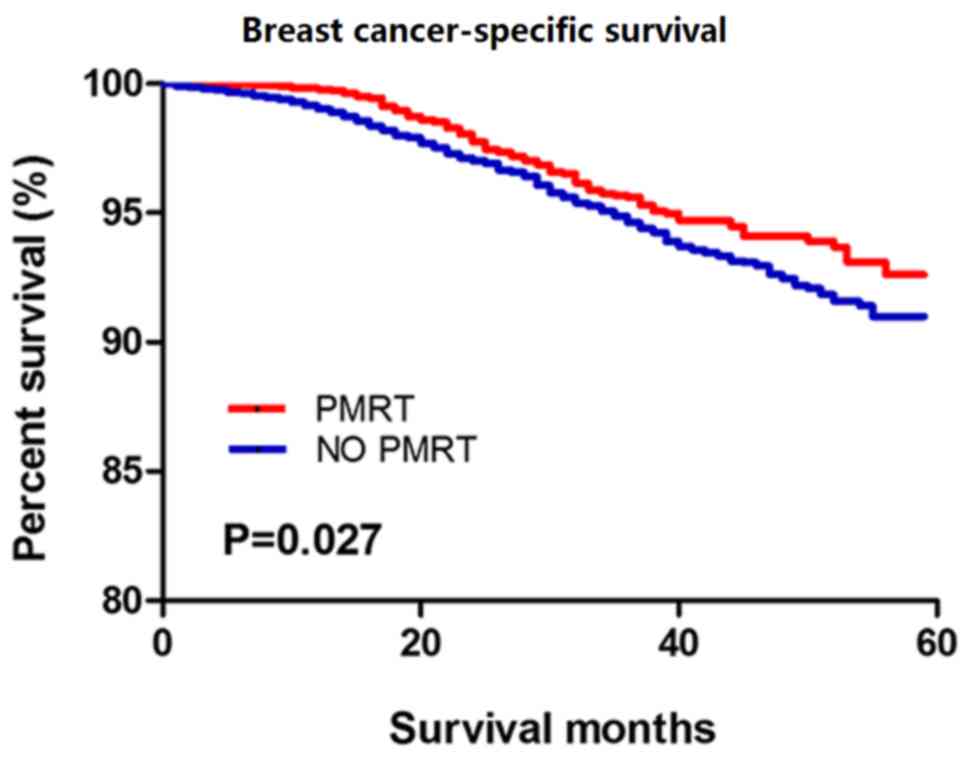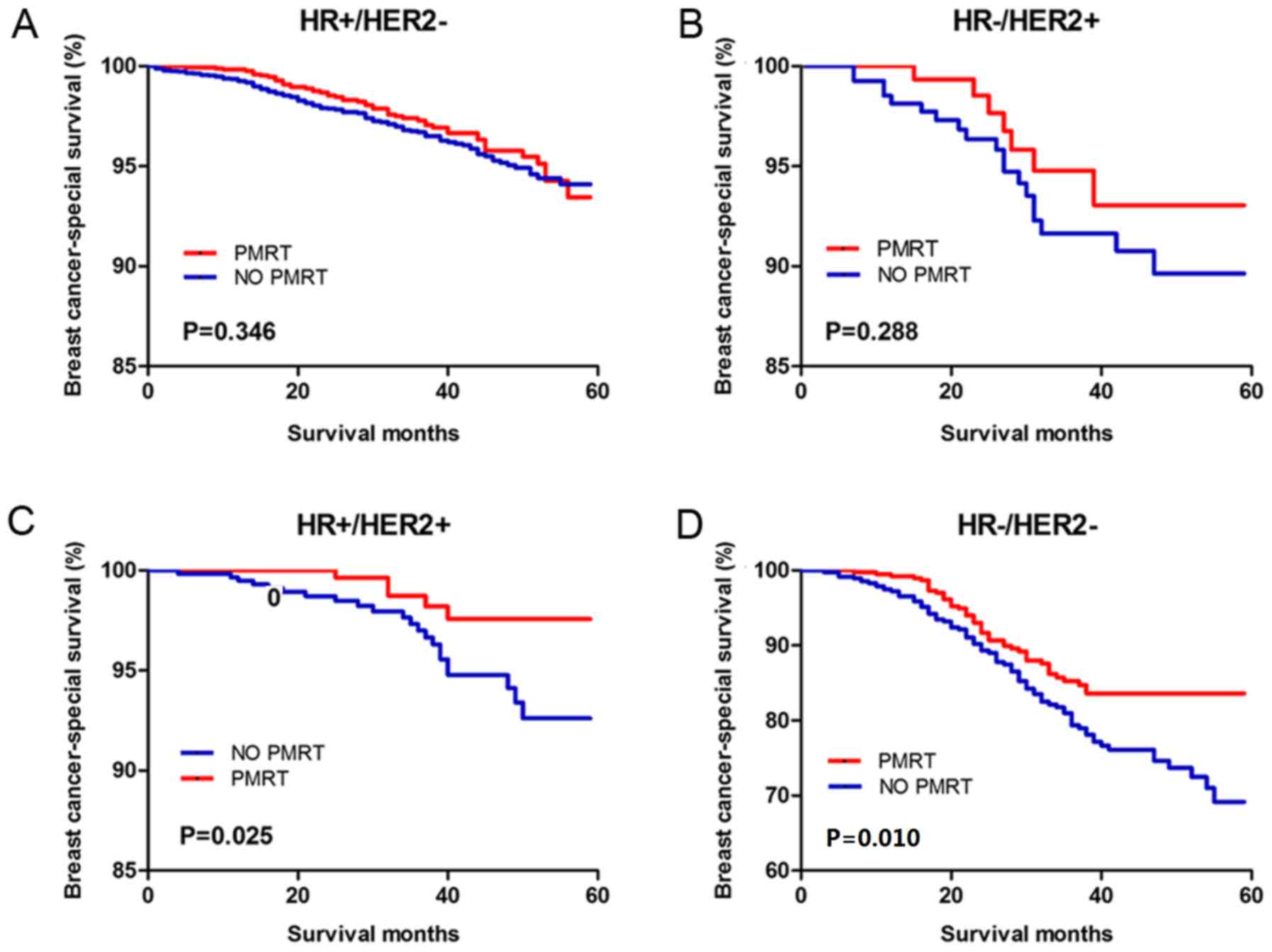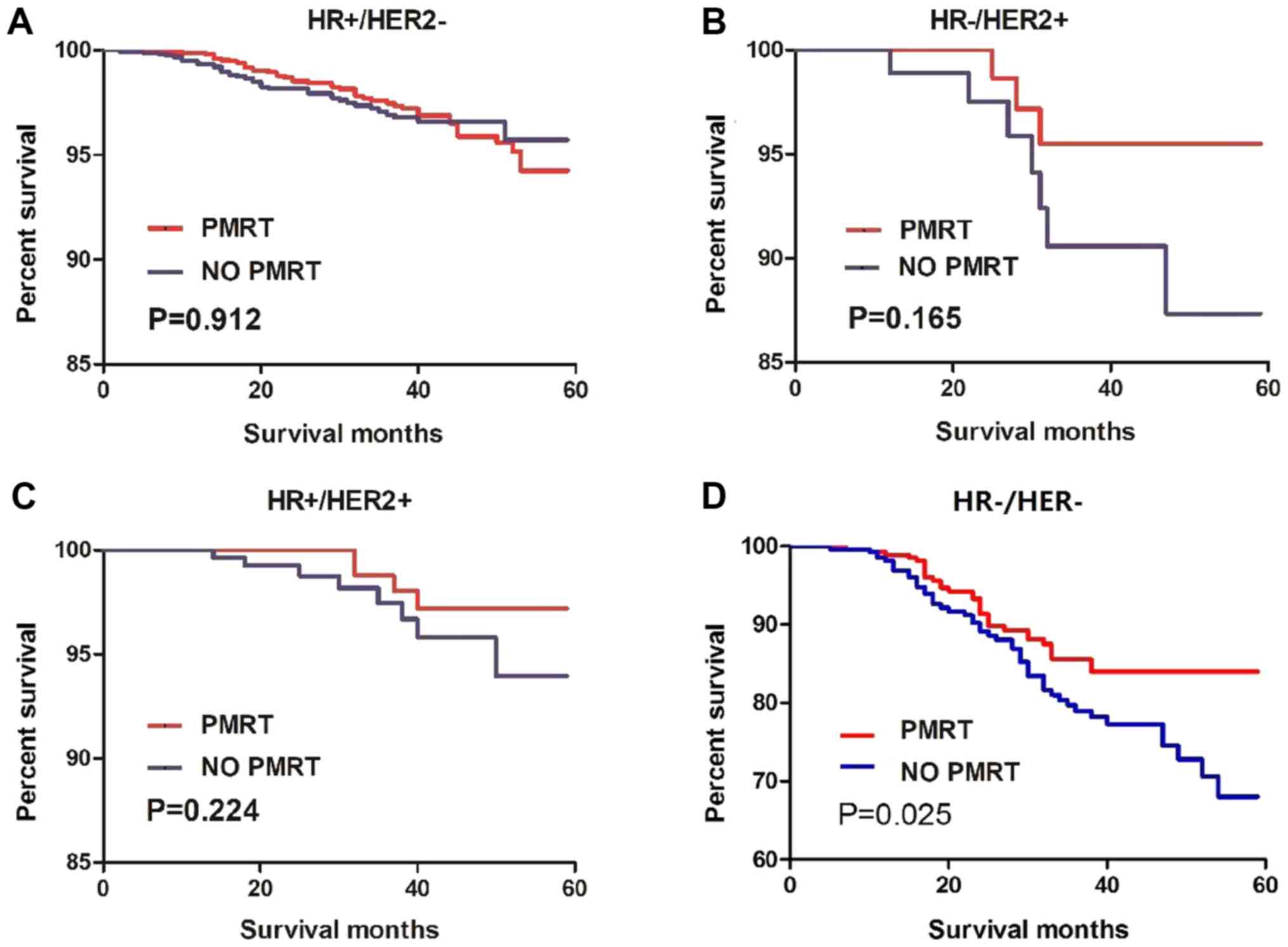|
1
|
Shi W, Luo Y, Zhao D, Huang H and Pang W:
Evaluation of the benefit of post-mastectomy radiotherapy in
patients with early-stage breast cancer: A propensity score
matching study. Oncol Lett. 17:4851–4858. 2019.PubMed/NCBI
|
|
2
|
Voduc KD, Cheang MC, Tyldesley S, Gelmon
K, Nielsen TO and Kennecke H: Breast cancer subtypes and the risk
of local and regional relapse. J Clin Oncol. 28:1684–1691. 2010.
View Article : Google Scholar : PubMed/NCBI
|
|
3
|
EBCTCG (Early Breast Cancer Trialists'
Collaborative Group), ; McGale P, Taylor C, Correa C, Cutter D,
Duane F, Ewertz M, Gray R, Mannu G, Peto R, et al: Effect of
radiotherapy after mastectomy and axillary surgery on 10-year
recurrence and 20-year breast cancer mortality: Meta-analysis of
individual patient data for 8135 women in 22 randomised trials.
Lancet. 383:2127–2135. 2014. View Article : Google Scholar : PubMed/NCBI
|
|
4
|
Senkus E, Kyriakides S, Ohno S,
Penault-Llorca F, Poortmans P, Rutgers E, Zackrisson S and Cardoso
F; ESMO Guidelines Committee, : Primary breast cancer: ESMO
clinical practice guidelines for diagnosis, treatment and
follow-up. Ann Oncol. 26 (Suppl 5):v8–v30. 2015. View Article : Google Scholar : PubMed/NCBI
|
|
5
|
Whelan TJ, Olivotto IA and Levine MN:
Regional nodal irradiation in early-stage breast cancer. N Engl J
Med. 373:1878–1879. 2015. View Article : Google Scholar : PubMed/NCBI
|
|
6
|
Poortmans PM, Collette S, Kirkove C, Van
Limbergen E, Budach V, Struikmans H, Collette L, Fourquet A,
Maingon P, Valli M, et al: Internal mammary and medial
supraclavicular irradiation in breast cancer. N Engl J Med.
373:317–327. 2015. View Article : Google Scholar : PubMed/NCBI
|
|
7
|
Edge SB and Compton CC: The American joint
committee on cancer: The 7th edition of the AJCC cancer staging
manual and the future of TNM. Ann Surg Oncol. 17:1471–1474. 2010.
View Article : Google Scholar : PubMed/NCBI
|
|
8
|
Mukesh MB, Duke S, Parashar D, Wishart G,
Coles CE and Wilson C: The Cambridge post-mastectomy radiotherapy
(C-PMRT) index: A practical tool for patient selection. Radiother
Oncol. 110:461–466. 2014. View Article : Google Scholar : PubMed/NCBI
|
|
9
|
Valla M, Vatten LJ, Engstrøm MJ, Haugen
OA, Akslen LA, Bjørngaard JH, Hagen AI, Ytterhus B, Bofin AM and
Opdahl S: Molecular subtypes of breast cancer: Long-term incidence
trends and prognostic differences. Cancer Epidemiol Biomarkers
Prev. 25:1625–1634. 2016. View Article : Google Scholar : PubMed/NCBI
|
|
10
|
Zardavas D, Irrthum A, Swanton C and
Piccart M: Clinical management of breast cancer heterogeneity. Nat
Rev Clin Oncol. 12:381–394. 2015. View Article : Google Scholar : PubMed/NCBI
|
|
11
|
Perou CM, Sørlie T, Eisen MB, van de Rijn
M, Jeffrey SS, Rees CA, Pollack JR, Ross DT, Johnsen H, Akslen LA,
et al: Molecular portraits of human breast tumours. Nature.
406:747–752. 2000. View
Article : Google Scholar : PubMed/NCBI
|
|
12
|
Cancer Genome Atlas Network, .
Comprehensive molecular portraits of human breast tumours. Nature.
490:61–70. 2012. View Article : Google Scholar : PubMed/NCBI
|
|
13
|
Wu CY, Du SL, Zhang J, Liang AL and Liu
YJ: Exosomes and breast cancer: A comprehensive review of novel
therapeutic strategies from diagnosis to treatment. Cancer Gene
Ther. 24:6–12. 2017. View Article : Google Scholar : PubMed/NCBI
|
|
14
|
Pusztai L, Broglio K, Andre F, Symmans WF,
Hess KR and Hortobagyi GN: Effect of molecular disease subsets on
disease-free survival in randomized adjuvant chemotherapy trials
for estrogen receptor-positive breast cancer. J Clin Oncol.
26:4679–4683. 2008. View Article : Google Scholar : PubMed/NCBI
|
|
15
|
Prat A, Lluch A, Albanell J, Barry WT, Fan
C, Chacón JI, Parker JS, Calvo L, Plazaola A, Arcusa A, et al:
Predicting response and survival in chemotherapy-treated
triple-negative breast cancer. Br J Cancer. 111:1532–1541. 2014.
View Article : Google Scholar : PubMed/NCBI
|
|
16
|
Howlader N, Altekruse SF, Li CI, Chen VW,
Clarke CA, Ries LA and Cronin KA: US incidence of breast cancer
subtypes defined by joint hormone receptor and HER2 status. J Natl
Cancer Inst. 106:dju0552014. View Article : Google Scholar : PubMed/NCBI
|
|
17
|
Gradishar WJ, Anderson BO, Balassanian R,
Blair SL, Burstein HJ, Cyr A, Elias AD, Farrar WB, Forero A,
Giordano SH, et al: Breast Cancer, Version 4.2017, NCCN clinical
practice guidelines in oncology. J Natl Compr Canc Netw.
16:310–320. 2018. View Article : Google Scholar : PubMed/NCBI
|
|
18
|
Yin H, Qu Y, Wang X, Ma T, Zhang H, Zhang
Y, Li Y, Zhang S, Ma H, Xing E, et al: Impact of postmastectomy
radiation therapy in T1-2 breast cancer patients with 1–3 positive
axillary lymph nodes. Oncotarget. 8:49564–49573. 2017. View Article : Google Scholar : PubMed/NCBI
|
|
19
|
Nordenskjold AE, Fohlin H, Albertsson P,
Arnesson LG, Chamalidou C, Einbeigi Z, Holmberg E, Nordenskjöld B
and Karlsson P; Swedish Western and Southeastern Breast Cancer
Groups, : No clear effect of postoperative radiotherapy on survival
of breast cancer patients with one to three positive nodes: A
population-based study. Ann Oncol. 26:1149–1154. 2015. View Article : Google Scholar : PubMed/NCBI
|
|
20
|
Chitapanarux I, Tharavichitkul E,
Jakrabhandu S, Klunklin P, Onchan W, Srikawin J, Pukanhaphan N,
Traisathit P and Vongtama R: Real-world outcomes of postmastectomy
radiotherapy in breast cancer patients with 1–3 positive lymph
nodes: A retrospective study. J Radiat Res. 55:121–128. 2014.
View Article : Google Scholar : PubMed/NCBI
|
|
21
|
He ZY, Wu SG, Zhou J, Li FY, Lin Q, Lin HX
and Sun JY: Postmastectomy radiotherapy improves disease-free
survival of high risk of locoregional recurrence breast cancer
patients with T1-2 and 1 to 3 positive nodes. PLoS One.
10:e01191052015. View Article : Google Scholar : PubMed/NCBI
|
|
22
|
Gnant M, Harbeck N and Thomssen C: St.
Gallen/Vienna 2017: A brief summary of the consensus discussion
about escalation and de-escalation of primary breast cancer
treatment. Breast Care (Basel). 12:102–107. 2017. View Article : Google Scholar : PubMed/NCBI
|
|
23
|
Goldhirsch A, Winer EP, Coates AS, Gelber
RD, Piccart- Gebhart M, Thürlimann B and Senn HJ; Panel members, :
Personalizing the treatment of women with early breast cancer:
Highlights of the St gallen international expert consensus on the
primary therapy of early breast cancer 2013. Ann Oncol.
24:2206–2223. 2013. View Article : Google Scholar : PubMed/NCBI
|
|
24
|
Chen HL, Ding A and Wang FW: Prognostic
effect analysis of molecular subtype on young breast cancer
patients. Chin J Cancer Res. 27:428–436. 2015.PubMed/NCBI
|
|
25
|
Shen H, Zhao L, Wang L, Liu X, Liu X, Liu
J, Niu F, Lv S and Niu Y: Postmastectomy radiotherapy benefit in
Chinese breast cancer patients with T1-T2 tumor and 1–3 positive
axillary lymph nodes by molecular subtypes: An analysis of 1369
cases. Tumour Biol. 37:6465–6475. 2016. View Article : Google Scholar : PubMed/NCBI
|
|
26
|
Wang J, Shi M, Ling R, Xia Y, Luo S, Fu X,
Xiao F, Li J, Long X, Wang J, et al: Adjuvant chemotherapy and
radiotherapy in triple-negative breast carcinoma: A prospective
randomized controlled multi-center trial. Radiother Oncol.
100:200–204. 2011. View Article : Google Scholar : PubMed/NCBI
|
|
27
|
Moo TA, McMillan R, Lee M, Stempel M, Ho
A, Patil S and El-Tamer M: Impact of molecular subtype on
locoregional recurrence in mastectomy patients with T1-T2 breast
cancer and 1–3 positive lymph nodes. Ann Surg Oncol. 21:1569–1574.
2014. View Article : Google Scholar : PubMed/NCBI
|
|
28
|
Abdulkarim BS, Cuartero J, Hanson J,
Deschênes J, Lesniak D and Sabri S: Increased risk of locoregional
recurrence for women with T1-2N0 triple-negative breast cancer
treated with modified radical mastectomy without adjuvant radiation
therapy compared with breast-conserving therapy. J Clin Oncol.
29:2852–2858. 2011. View Article : Google Scholar : PubMed/NCBI
|
|
29
|
Nguyen PL, Taghian AG, Katz MS, Niemierko
A, Abi Raad RF, Boon WL, Bellon JR, Wong JS, Smith BL and Harris
JR: Breast cancer subtype approximated by estrogen receptor,
progesterone receptor, and HER-2 is associated with local and
distant recurrence after breast-conserving therapy. J Clin Oncol.
26:2373–2378. 2008. View Article : Google Scholar : PubMed/NCBI
|
|
30
|
Sjöström M, Lundstedt D, Hartman L,
Holmberg E, Killander F, Kovács A, Malmström P, Niméus E, Werner
Rönnerman E, Fernö M and Karlsson P: Response to radiotherapy after
breast-conserving surgery in different breast cancer subtypes in
the swedish breast cancer group 91 radiotherapy randomized clinical
trial. J Clin Oncol. 35:3222–3229. 2017. View Article : Google Scholar : PubMed/NCBI
|
|
31
|
Cleator S, Heller W and Coombes RC:
Triple-negative breast cancer: Therapeutic options. Lancet Oncol.
8:235–244. 2007. View Article : Google Scholar : PubMed/NCBI
|
|
32
|
Yu T and Di G: Role of tumor
microenvironment in triple-negative breast cancer and its
prognostic significance. Chin J Cancer Res. 29:237–252. 2017.
View Article : Google Scholar : PubMed/NCBI
|


















